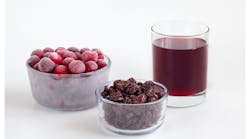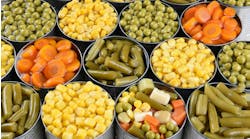Few ingredients fit within current food trends as well as real fruit. As consumers continue to redefine clean label and search for increased transparency or nutrient-rich offerings, the overarching theme appears to be a more holistic approach to foods and beverages. This positions fruit ingredients as an attractive option for formulators.
Whether present to provide the background whisper of flavor in teas, particulate identity in cereals and snack bars or to confer health benefits in the sports performance category, there is a fruit ingredient – and form -- suitable for almost any application.
When it comes to fruit-based ingredients, formulators have a wide variety of forms from which to choose, with major choices including juice, puree, concentrates in different strengths, freeze-dried, IQF or powders.
Various factors can affect fruit quality and availability, such as soil conditions, rainfall and other weather-related issues. “The main challenges to fruit formulation and processing often come down to availability and format options,” says Jeannette Ferrary for the U.S. Highbush Blueberry Council (www.realblueberries.org).
However the good news is that processors and ingredient suppliers often have a network of fruit growers from different regions to compensate for a lack of supply or quality for a particular type of fruit, according to Ed Maguire, an independent consultant with FLX Research. Even tropical fruits currently in vogue can be sourced from a several geographical regions, he notes.
The compensation or adjustments often involve balancing the Brix/acid ratio. This is a specification the end user can request from its supplier. That sort of compensation can be performed by the initial fruit processor or moved “upstream” to a further processor that creates filling or ribbons used in ice cream or baking, for example, to stabilize the viscosity and sweetness levels.
A Brix Briefing
While Brix value is commonly associated with sugar, the most prevalent solid in many fruit and vegetable juices, Brix expresses the level of all solids, including sugars, pectins, organic acids and amino acids. The Brix scale equals the percent of dissolved solids in a solution. For example, a 100g sample of a solution that measures 40° Brix has 40g of sugar and other dissolved solids and 60g of water.
The natural Brix of fruit can vary depending on the growing climate and from crop year to crop year. It may be common to adjust a product formulation to account for seasonal flavor profile differences or to choose a fruit blend to help standardize desired quality and flavor attributes.
Ed Maguire, an independent consultant with FLX Research, notes that manufacturers must consider the Brix/acid ratio in any fruit ingredient. “If that is in line, even if Brix is a little high or a little low, it becomes a simple potency issue.
When the ratio of the two shifts -- either more acid than normal compared to solids or vice versa -- that’s when it becomes tricky. The manufacturer will need to compensate with sweetener from a different source because when if the acid level is adjusted downward, the sugar content dips as well.
An industry standard preparation in this case is a “five plus one,” says Maguire -- five parts fruit to one part sugar, prepared by a specialty ingredient manufacturer, packed and ready to use in baking, confections or ice cream preparations.
Puree vs. concentrate
Two of the major available forms, purees and concentrates, vary in terms of the Brix level. The two forms have different labeling impacts as well.
A single strength fruit puree supplies fruit at the same Brix level as the fruit itself. According to Tim Heim of TreeTop Fruit Ingredients, a single-strength apple puree is “like biting into an apple. The taste is more natural because it doesn’t see as much heat as other forms of processing — it doesn’t pass through an evaporator.”
Certain manufacturers prefer puree because it has a more consumer-friendly label presence, whereas a concentrate has to be listed as such.
Fruit concentrate or puree may be ideal for use in a relatively high-moisture application such as beverages or batter mixes, while traditionally dried, freeze-dried or powdered fruit may have more advantages for a dry mix format, says Steve Somsel, ingredient sales manager for Shoreline Fruit LLC (www.shorelinefruit.com).
Other variables to consider when choosing between a puree and a concentrate include viscosity, Brix standardization acidity and freight costs.
Viscosity is easier to control and standardize with a concentrate, as is Brix level. A concentrate offers formulators a standardized Brix, according to Heim, “plus or minus a half or a full point.” Also, when reformulating or diluting a concentrate, the manufacturer can regulate viscosity and manipulate the titratable acidity.
Weather or locale can affect Brix levels. According to Heim, the Brix in California for a particular variety of apples, for instance, might be higher than one grown in the Pacific Northwest. Processors can stabilize these attributes in a single-strength puree by blending apple or fruit varieties.
Blending fruits from different regions also can help balance color and flavor, correct a low soluble solids level and emphasize nutritional or phytochemical properties, among other benefits.
Brix will vary depending on the fruit of origin and of course on the fruits blended together, with higher Brix levels in a concentrate compared to a puree. For example, lemon juice would be on the low end, ranging from 3° to 6° Brix while papaya juice can range from 40° to 70°1. A single-strength apple puree might have a Brix of 8° to 10°, whereas an apple concentrate might be standardized at 28° Brix. Blueberry concentrates can range from 45° to 65° Brix, according to Ferrary, and can be tailored to suit manufacturer’s requirements, as can other forms of fruit.
There are always trade-offs with any product choice. Some manufacturers prefer to use puree because the company doesn’t have to use the word “concentrate” on the label. In addition, the cost per Brix is lower for a concentrate than a single-strength product when manufacturers factor in freight costs.
Fruit for the Future
Trends that all fruit suppliers or processors interviewed, agreed they’re seeing in the industry include alcoholic beverages with real fruit flavors including both hard liquors and craft brewing. Teas and other light beverages seem to skew towards fruit flavors.
Hot and cold cereals and snack or nutrition bars used to rely solely upon raisins, dates, figs or perhaps apricots. But modern drying methods enable the use of strawberries, cherries, blueberries, cranberries and even tropical fruits.
Animal companions are not left out of this fruity trend. Pet foods from snacks to standard kibble now include ingredients such as low-moisture and evaporated apples, blueberries or tart cherries for their anthocyanin and antioxidant benefits.
High in antioxidants…and microbial count
According to Maguire, part of the increased interest in real fruit can be linked to potential benefits for sports performance products or those targeting an aging population dealing with maladies ranging from Alzheimer’s to osteoarthritis. “This is being fueled by recent research and scientific papers discussing the ways natural foods could possibly replace the various pharmaceuticals on our shelves,” he says.
Fruits and vegetables, particularly those with bright colors, such as tart cherries, are valued for their antioxidant and anti-inflammatory potential. “The goal is to maximize phytochemical retention in an ingredient that is microbially stable and yet easy to use in any format,” Maguire adds.
This requires formulators to execute a tight balancing act between reduction of microbial activity while retaining vitamins, phytochemicals and color. “Often times these actions are on opposite ends of the spectrum,” says Maguire. Dehydrated fruit, for example, used in trail mix, tends to be stable microbially, “but not the most colorful.”
He went on to say that high-pressure pasteurization preserves vitamins, but won’t provide a shelf-stable microbial count. Freeze-dried fruits help retain colors and much of the potent flavor and phytochemicals contained in fresh fruit, “however, it does nothing to reduce microbial count,” says Maguire.
Freeze drying stabilizes the fruit when served by itself or in a low water activity system. However, as soon as it is rehydrated, “it has the same microbial count as fruit that has been sitting for a day to be processed.”
Freeze dried fruit most often is used when water activity (aW) is a major concern, says Shoreline's Somsel. A cereal product emphasizing the presence of real fruit may choose a freeze-dried fruit inclusion to prevent the cereal from absorbing moisture from a dried fruit with a higher moisture level.
IQF or individually quick frozen fruit offers individual fruit piece identity in baked goods like muffins, sweet breads or desserts. Most often, for example, IQF blueberries do not need to be thawed prior to use. “They (IQF blueberries) can be poured into batters, quickly incorporated into mixes or used as a topping,” according to Ferrary.
Air-dried fruit may have an aW level of 0.60, which is shelf stable but will contain a higher level of moisture than a dry cereal. Freeze dried fruit, with an aW of about 0.3 is about equal to that of the cereal and will help keep the cereal from going prematurely stale.
Another option is a low-heat drying process such as that employed by Milne MicroDried. The company starts with whole IQF fruit and vegetables and dehydrates the product using low heat technology inside of a vacuum, claiming to preserve most of the original size, natural color and texture.
According to Steve Nugent, director of export, dried and frozen sales for Milne MicroDried, the end result is also low in water activity, moisture and microbe levels, for a two-year shelf life. That makes the fruit suitable for use in blends, cereals and other snack applications where particulate identity is important. The product is available in whole or fragmented pieces as well as 100 percent fruit powders, to help provide a real fruit label claim.
Consider the pH
A fruit’s pH is another important consideration when formulating. Dairy products for example, cannot handle a fruit inclusion with too high a level of acidity or it could cause the end product to curdle, according to Somsel.
Even a creamsicle-flavored liqueur has difficultly using real fruit compared to an extract or natural flavor because the fruit’s acid curdles the dairy, says Maguire. The more a processor works to adjust pH, acidity or a product’s microbial stability, the further the product could potentially wander away from its intended flavor.
“The tough part of adjusting acidity and fruits is that, in most cases, acidity and sugar come out together,” he says. "You can remove some of the acidity, but then you remove the sugar with it.” Then, in an effort to replace the sugar, the manufacturer might infuse extra sugar into the solution, “but the flavor changes,” he warns.
“A banana for instance, that has been over-acidified for shelf stability stops being recognizable as pure banana," says Maguire. "Even though there may not be any other fruits in the mixture, it may taste like banana-and-something. So chemically it might work, but the flavor doesn’t hit the mark.”
Ferrary notes that blueberries have a low pH range, which increases storage stability.
Beyond any consumer desire for clean labels and minimal processing, taste is still what ultimately sells a product. And fruits seldom disappoint.


